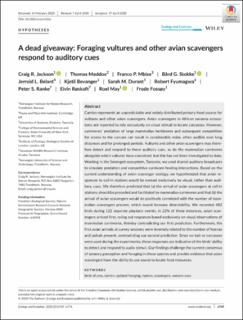| dc.contributor.author | Jackson, Craig Ryan | |
| dc.contributor.author | Maddox, Thomas M | |
| dc.contributor.author | Mbise, Franco Peniel | |
| dc.contributor.author | Stokke, Bård Gunnar | |
| dc.contributor.author | belant, Jerrold L. | |
| dc.contributor.author | Bevanger, Kjetil Modolv | |
| dc.contributor.author | Durant, Sarah M. | |
| dc.contributor.author | Fyumagwa, R.D. | |
| dc.contributor.author | Ranke, Peter Sjolte | |
| dc.contributor.author | Røskaft, Eivin | |
| dc.contributor.author | May, Roelof Frans | |
| dc.contributor.author | Fossøy, Frode | |
| dc.date.accessioned | 2021-01-15T11:10:06Z | |
| dc.date.available | 2021-01-15T11:10:06Z | |
| dc.date.created | 2020-05-20T09:10:59Z | |
| dc.date.issued | 2020 | |
| dc.identifier.citation | Ecology and Evolution. 2020, 10 (13), 6769-6774. | en_US |
| dc.identifier.issn | 2045-7758 | |
| dc.identifier.uri | https://hdl.handle.net/11250/2723237 | |
| dc.description.abstract | Carrion represents an unpredictable and widely distributed primary food source for vultures and other avian scavengers. Avian scavengers in African savanna ecosystems are reported to rely exclusively on visual stimuli to locate carcasses. However, carnivores’ predation of large mammalian herbivores and subsequent competition for access to the carcass can result in considerable noise, often audible over long distances and for prolonged periods. Vultures and other avian scavengers may therefore detect and respond to these auditory cues, as do the mammalian carnivores alongside which vultures have coevolved, but this has not been investigated to date. Working in the Serengeti ecosystem, Tanzania, we used diurnal auditory broadcasts to simulate predation and competitive carnivore feeding interactions. Based on the current understanding of avian scavenger ecology, we hypothesized that avian responses to call‐in stations would be evoked exclusively by visual, rather than auditory, cues. We therefore predicted that (a) the arrival of avian scavengers at call‐in stations should be preceded and facilitated by mammalian carnivores and that (b) the arrival of avian scavengers would be positively correlated with the number of mammalian scavengers present, which would increase detectability. We recorded 482 birds during 122 separate playback events. In 22% of these instances, avian scavengers arrived first, ruling out responses based exclusively on visual observations of mammalian carnivores, thereby contradicting our first prediction. Furthermore, the first avian arrivals at survey sessions were inversely related to the number of hyenas and jackals present, contradicting our second prediction. Since no bait or carcasses were used during the experiments, these responses are indicative of the birds’ ability to detect and respond to audio stimuli. Our findings challenge the current consensus of sensory perception and foraging in these species and provide evidence that avian scavengers have the ability to use sound to locate food resources. | en_US |
| dc.language.iso | eng | en_US |
| dc.publisher | John Wiley & Sons Ltd | en_US |
| dc.rights | Navngivelse 4.0 Internasjonal | * |
| dc.rights.uri | http://creativecommons.org/licenses/by/4.0/deed.no | * |
| dc.title | A dead giveaway: Foraging vultures and other avian scavengers respond to auditory cues | en_US |
| dc.type | Peer reviewed | en_US |
| dc.type | Journal article | en_US |
| dc.description.version | publishedVersion | en_US |
| dc.source.pagenumber | 6769-6774 | en_US |
| dc.source.volume | 10 | en_US |
| dc.source.journal | Ecology and Evolution | en_US |
| dc.source.issue | 13 | en_US |
| dc.identifier.doi | https://doi.org/10.1002/ece3.6366 | |
| dc.identifier.cristin | 1811838 | |
| dc.description.localcode | This is an open access article under the terms of the Creative Commons Attribution License, which permits use, distribution and reproduction in any medium, provided the original work is properly cited. | en_US |
| cristin.ispublished | true | |
| cristin.fulltext | original | |
| cristin.qualitycode | 1 | |

